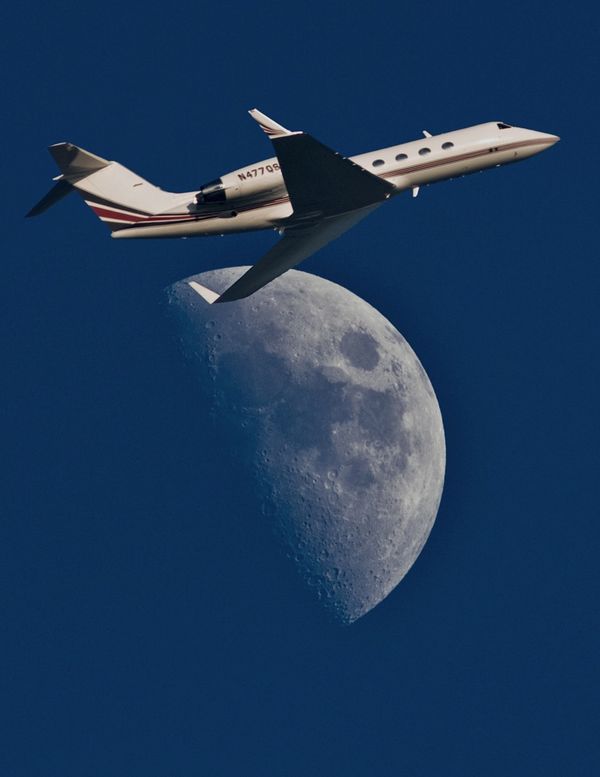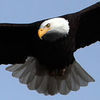Help needed for Moon shots over landscape at dawn or dusk
Oct 20, 2011 17:44:53 #
I am really interested in how to photograph the moon over a landscape at dusk or dawn so that the details of the moon actually show up. Every effort i have made just shows the moon as a big blob in the sky. I really want that detail of the moon to show, while also capturing everything else clearly and in focus. I want to be sure to capture the sky correctly too.
Any help with advice and settings would be super appreciated!!
Thank you!!!
Any help with advice and settings would be super appreciated!!
Thank you!!!
Oct 20, 2011 17:49:06 #
Use spot metering, lock exposure on the moon, then recompose the photo and shoot, you'll need a tripod.
Eric
Eric
Oct 20, 2011 17:50:47 #
Oct 20, 2011 17:54:01 #
i can get moon detail just fine at f11 @ 1/125. the problem is i lose everything else. if your shutter is too slow, the moon elongates. if the lens is too open, you get the blob. maybe it's time for subtle HDR?
Oct 20, 2011 18:12:54 #
For focusing purposes, the moon can be considered an infinite distance from earth. It is always noon daylight on the lighted side of the moon, so your exposure should be 1/ISO (shutter speed) at f/16 (aperture). Full moon, half moon, quarter moon will be the same exposure, or very close.
Recommended starting exposure at ISO 400, manual settings of 1/400-sec at f/16, lens at infinite focal distance.
At ISO 200, 1/200-sec at f/16 is equivalent exposure, but the longer your lens, the fast your shutter speed to reduce camera shake. Longer lenses means faster shutter speed and a little wider aperture.
When using a tripod turn OFF your IS (Image Stabilization) or VR (Vibration Reduction).
Shooting straight-up (or as close to up as possible), the moon is viewed through minimal earth atmosphere. Shooting at the moon near horizon is through the thickest atmospheric path, resulting in loss of detail.
Rising moons are orange because of the suspended dust in the earth's atmosphere. Better to shoot straight up, then merge a large moon photo with a horizon photo to obtain a dramatic moonrise.
A prime lens will always be sharper than a zoom lens. The longer your lens, the less cropping required to enlarge image.
Recommended starting exposure at ISO 400, manual settings of 1/400-sec at f/16, lens at infinite focal distance.
At ISO 200, 1/200-sec at f/16 is equivalent exposure, but the longer your lens, the fast your shutter speed to reduce camera shake. Longer lenses means faster shutter speed and a little wider aperture.
When using a tripod turn OFF your IS (Image Stabilization) or VR (Vibration Reduction).
Shooting straight-up (or as close to up as possible), the moon is viewed through minimal earth atmosphere. Shooting at the moon near horizon is through the thickest atmospheric path, resulting in loss of detail.
Rising moons are orange because of the suspended dust in the earth's atmosphere. Better to shoot straight up, then merge a large moon photo with a horizon photo to obtain a dramatic moonrise.
A prime lens will always be sharper than a zoom lens. The longer your lens, the less cropping required to enlarge image.
Oct 20, 2011 18:45:59 #
Thanks all! I have been able to photograph the full moon by itself pretty easily, but when shooting it to include in a landscape shot and still get that detail, that's where I've had trouble.
Now I've discovered that my camera (the Rebel XS) does not have a spot meter, so I may need to buy an external one?
Any suggestions with that?
Now I've discovered that my camera (the Rebel XS) does not have a spot meter, so I may need to buy an external one?
Any suggestions with that?
Oct 20, 2011 19:27:29 #
I think all cameras have a spot metering function. Do we have any Rebel users that can help him find it? I'm an Oly guy and wouldn't know where to look on a Canon. Stopping down your aperture to its minimum (highest F-number) will help with getting everything in focus.
Eric
Eric
Oct 20, 2011 19:45:07 #
[quote=
Shooting straight-up (or as close to up as possible), the moon is viewed through minimal earth atmosphere. Shooting at the moon near horizon is through the thickest atmospheric path, resulting in loss of detail.
quote]
wont comment on rest of your comment,,when moon comes through more atmosfier it will appear larger than when taken "straight up"
Shooting straight-up (or as close to up as possible), the moon is viewed through minimal earth atmosphere. Shooting at the moon near horizon is through the thickest atmospheric path, resulting in loss of detail.
quote]
wont comment on rest of your comment,,when moon comes through more atmosfier it will appear larger than when taken "straight up"
Oct 20, 2011 20:59:12 #
You probobly wont like this answer but my best results have been with my Mamiya rb67-ASA 800 film- and my 360mm lens.
Every time I use my digital the results are not satisfactory.
However I am just a prejudiced old film shooter.
Every time I use my digital the results are not satisfactory.
However I am just a prejudiced old film shooter.
Oct 20, 2011 21:13:21 #
henrycrafter wrote:
You probobly wont like this answer but my best results have been with my Mamiya rb67-ASA 800 film- and my 360mm lens.
Every time I use my digital the results are not satisfactory.
However I am just a prejudiced old film shooter.
Every time I use my digital the results are not satisfactory.
However I am just a prejudiced old film shooter.
Henry,
The digital Ninjas are on their way to your house even as I type this; that 360mm lens would make a great defensive weapon :)
Eric
Oct 20, 2011 21:47:53 #
Welcome, quirkel
I have the Rebel XSi and when I want to change the metering mode I just press the 'up' arrow on the cross keys. Metering Mode will appear then just use the 'up' or 'down' key to select 'spot metering' then press 'set'. Good luck-hope this helps.
I have the Rebel XSi and when I want to change the metering mode I just press the 'up' arrow on the cross keys. Metering Mode will appear then just use the 'up' or 'down' key to select 'spot metering' then press 'set'. Good luck-hope this helps.
Oct 20, 2011 21:54:50 #
henrycrafter wrote:
You probobly wont like this answer but my best results have been with my Mamiya rb67-ASA 800 film- and my 360mm lens.
Every time I use my digital the results are not satisfactory.
However I am just a prejudiced old film shooter.
Every time I use my digital the results are not satisfactory.
However I am just a prejudiced old film shooter.
oh that is cheating,,you just brought in one of my [wish I had that] dreams.. a medium format..can do so much with that,,the next size film camera I want...--joe
Oct 20, 2011 22:20:30 #
rebelshooter wrote:
Welcome, quirkel
I have the Rebel XSi and when I want to change the metering mode I just press the 'up' arrow on the cross keys. Metering Mode will appear then just use the 'up' or 'down' key to select 'spot metering' then press 'set'. Good luck-hope this helps.
I have the Rebel XSi and when I want to change the metering mode I just press the 'up' arrow on the cross keys. Metering Mode will appear then just use the 'up' or 'down' key to select 'spot metering' then press 'set'. Good luck-hope this helps.
rebelshooter,
Thanks for that, I knew there had to be a spot metering function on the Rebel somewhere.
Eric
Oct 21, 2011 02:30:38 #
Well, this spells out the difference between your eyes and the limitations of photography. The foreground is a "night" exposure, the moon, a massively different as a "daylight" exposure.
HDR will not handle this very easily. It is much easier to cheat with two exposures, and just drop in the moon into the properly shot foreground.
HDR will not handle this very easily. It is much easier to cheat with two exposures, and just drop in the moon into the properly shot foreground.
Simple composite with moon.

Oct 21, 2011 06:46:56 #
I think I'd use a little HDR with this, but if you don't want to...picking your time might be your best bet. Bryan Peterson recommends in Understanding Exposure that you photograph the moon the day before the calendar says it is full. That way, the eastern sky and the landscape below are at nearly the same exposure value.
Also, you might have better luck if the moon is rising at the same time the sun is setting. Lots of websites have sunset and moonrise times for specific locations; choose a night where the times are close (within 15-20 minutes).
Also, you might have better luck if the moon is rising at the same time the sun is setting. Lots of websites have sunset and moonrise times for specific locations; choose a night where the times are close (within 15-20 minutes).
If you want to reply, then register here. Registration is free and your account is created instantly, so you can post right away.







